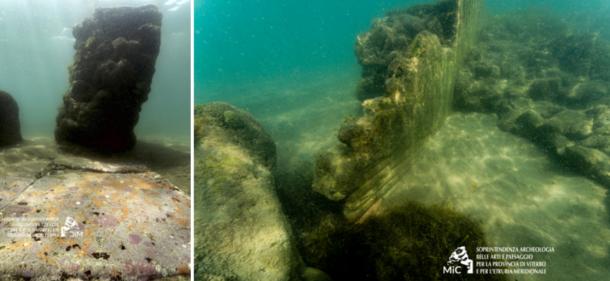
Ancient Roman Maritime Pavilion Excavated off Italy’s Coast
A significant archaeological discovery has been made off the coast of Campo di Mare, Italy, revealing a submerged Roman-era structure that once formed part of a grand villa complex. This find is the latest in a three-year initiative by the Soprintendenza Archeologia Belle Arti Paesaggio Etruria Meridionale to excavate and preserve ancient Roman architecture lost to the sea over time.
Initial Discovery and Architectural Significance
The excavation began in earnest in 2021 when researchers from Soprintendenza Archeologia Belle Arti Paesaggio Etruria Meridionale uncovered a cipollino marble column with its Ionic capital. This column was part of a circular structure, approximately 50 meters (164 feet) in diameter, lying just a few meters from the coastline. The structure has been identified as a maritime pavilion, believed to have been part of a larger Roman villa.

Part of the maritime pavilion. (Soprintendenza Archeologia Belle Arti Paesaggio Etruria Meridionale)
The pavilion's construction demonstrates notable architectural sophistication. Under the direction of the Underwater Archaeology Service of the Superintendency and supported by CSR Restauro Beni Culturali, the excavation team uncovered two concentric belts of brick walls.
These walls, built using double layers of triangular bricks and mortar, were spaced about three meters (10 feet) apart and founded on a clay base that helped preserve wooden formwork and numerous foundation posts.
Opulent Decorative Elements
Within the pavilion, the excavation team found opus spicatum flooring, a herringbone brick pattern commonly used in Roman architecture. Additionally, traces of opus signinum, a type of waterproof Roman concrete made from broken pottery, amphorae, tiles, and bricks, were discovered. This material was essential for structures requiring waterproofing, such as baths and aqueducts.
Fragments of opus sectile pavement, known for its intricate inlaid designs, further highlighted the pavilion's luxury. This decorative technique was typically reserved for the most elegant and opulent settings in Roman times.

The opus spicatum flooring, with bricks laid in a herringbone pattern. (Soprintendenza Archeologia Belle Arti Paesaggio Etruria Meridionale)
Challenges and Preservation Efforts
The excavation faced numerous challenges, including the normal difficulties of marine investigations, and coastal erosion. Despite these obstacles, the team progressed with the documentation and restoration of the site. The wooden parts of the structure in particular required meticulous cleaning, restoration, and consolidation, which underwater restorers from CSR Restauro Beni Culturali carried out.
The discovery and subsequent analysis of the pavilion suggest it was a luxurious and significant part of a Roman villa, strategically located near the ancient Via Aurelia. This route was crucial during the Roman era, connecting Rome with various coastal and inland regions. The pavilion's architectural elements imply that it may have belonged to a high-ranking member of the Roman aristocracy.

A marine archaeologist examines part of the structure. (Soprintendenza Archeologia Belle Arti Paesaggio Etruria Meridionale)
Future research, including geophysical surveys by the National Institute of Geophysics and Volcanology (INGV), aims to provide a more detailed understanding of the site and ensure its preservation against ongoing coastal erosion.
This discovery highlights the rich and sophisticated architectural heritage of ancient Rome, offering valuable insights into the luxurious lifestyles of its aristocracy.
Top image: Left; Aerial view of the Roman pavilion of the coast of Campo di Mare, Italy. Right, part of the submerged structure. Source: Soprintendenza Archeologia Belle Arti Paesaggio Etruria Meridionale
By Gary Manners















